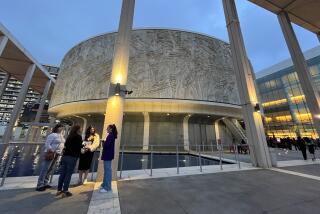Difficult truths to face as theater leaders talk diversity, economics
In 21st century America, there is one subject even more difficult to discuss honestly in public than race: money.
It took a while but near the end of Monday evening’s diversity forum featuring the artistic leaders of Southern California’s most prominent nonprofit theaters, the issue everyone was skirting was finally being loudly addressed.
Barry Edelstein, still settling into his job as artistic director of San Diego’s Old Globe, articulated the biggest obstacle to change in the American theater: “the inertia of the business model” that stems from “the fear” of jeopardizing the budgetary status quo.
CRITICS’ PICKS: What to watch, where to go, what to eat
A single flop can result not only in a loss of the earned income that nonprofit theaters are relying on to an ever-greater extent, but also in a backlash with philanthropic giving that can have dire institutional consequences. It’s no wonder that in lean economic times artistic decision-making bends in a more conservative direction.
Translation: more shows featuring white folks singing light FM and more old comedies featuring white folks telling jokes that weren’t that funny the first time around.
The panel — hosted by the Pasadena Playhouse in conjunction with the Stage Directors and Choreographers Foundation and East West Players, and moderated by Michael John Garcés (Cornerstone Theater Company) — was convened to discuss diversity “through a director’s eye.”
In addition to Edelstein, the group included Christopher Ashley (La Jolla Playhouse), Tim Dang (East West Players), Sheldon Epps (Pasadena Playhouse), Jessica Kubzansky (The Theatre @ Boston Court), Marc Masterson (South Coast Repertory), Michael Ritchie (Center Theatre Group) and Seema Sueko (incoming associate artistic director of Pasadena Playhouse and former executive artistic director of Mo`olelo Performing Arts Company).
The discussion proceeded with a discursive informality that left no one pinned to the mat for long. Dang and Sueko posed the sharpest concerns.
PHOTOS: Arts and culture in pictures by The Times
Dang wanted to know why a play by an African American author is often directed by an African American director at a mainstream theater while it’s rare to see a play by an Asian American playwright directed by an Asian American director at the same venue. Sueko chided her colleagues not to assume a condescending authority, however unintentional, when doing outreach. It took a member of the audience to raise the subject of disabilities.
What the proceedings needed was a troublemaker to flush out the unspoken tensions. A spirit of civility censored the most difficult truths.
Ritchie, head of California’s largest nonprofit theater and looking at times as though he were steeling himself for a blow, raised the issue of his controversial decision early in his tenure to disband the CTG playwriting labs that served marginalized artists. While recognizing the harmful public relations he caused himself, he touted his record on diversity, saying that though he hadn’t yet done the math he would bet that CTG would rank near the top of nonprofits theaters in terms of multicultural programming.
No one challenged Ritchie on this score, though Dang shared that he has sometimes been surprised by the exciting new work that has been brought to him by artists who have felt that the Mark Taper Forum was closed off to them.
Edelstein wasn’t alone in observing that the demographics of the traditional subscriber base — old, affluent and white — don’t reflect the demographics of the broader society that these nonprofit theaters were established through public and foundation money to serve.
PHOTOS: Hollywood stars on stage
But this economic conundrum — that the population generously propping up this art form may be inadvertently inhibiting its inclusiveness — won’t be solved easily.
“Baby steps” and “elbow grease” were phrases that were resorted to by leaders who would like to be agents of progressive change yet don’t want to be responsible for bringing about the downfall of these “old theaters,” as a panelist called the larger institutions represented here.
The face of America is changing and, as Dang observed, Southern California is “ground zero” for this demographic shift. The theater must cultivate new audiences or risk extinction. But as too many of these institutions have fallen into the habit of appealing to familiar customers, they must learn new methods of audience development. Everyone recognizes the urgency of the challenge, but the process is a bit like turning around a giant cruise ship. The threat of capsizing is ever present.
Idealism is of course easier without the accounting. Early in the discussion Ashley talked about how being an artistic director is like being the host of a party that includes not just artists and audiences but board members and staff and that diversity across these realms is key to throwing a lively bash. Masterson spoke about the role of “curiosity” as a natural instigator to exploring the human condition from all walks of life.
Dang said that it is incumbent on artistic leaders to ask themselves, “How are we going to tell this story and who are we going to tell this story to?” Sueko reminded her colleagues that theaters need communities even more than communities need theaters and that listening should be the first order of business for artistic directors.
PHOTOS: LA Opera through the years
There was a call for more general integration of season programming. Jokes were made about the African American slot, usually occurring in February to coincide with African American history month. Kubzansky said that the fact that theaters can always do better shouldn’t be seen as an indication that change isn’t happening behind the scenes. She implored artists not to self-segregate out of a sense of futility.
Epps said that when he first came to Pasadena Playhouse he found it “appalling” that he sometimes felt as if he were “the only person of any color” in attendance. He has made it central to his mission to diversify both his programming and his audience and his exemplary commitment demonstrates just how much headway can be made even at a theater that just a few years ago had to close its door to get its financial house in order.
If this means balancing a revival of “Twelve Angry Men” evenly cast with African American and white actors with commercial fare such as “One Night With Janis Joplin,” so be it.
Not all patrons were happy with the shift in course, Epps acknowledged with some wryness. But as Masterson, who directed an African American production of “Death of a Salesman” this season at SCR noted, artistic directors have to learn to say goodbye to the more close-minded factions of the old guard.
But there’s a deeper issue I wish these institutional leaders had addressed: artistic diversity. The most interesting playwrights in America already constitute a diverse pool. They just aren’t necessarily writing for houses of 750 people. How can artistic directors do a better job of providing a platform for these artists so that they can broaden their (and their directorial collaborators’) reach while opening the door to the next generation of theatergoers?
Diversifying an increasingly commercial operation is better than keeping it homogenous, but can’t we ask more of our institutions, our artists and ourselves? Diversity, after all, should be a means toward a greater artistic end.
Holding the American theater back isn’t a prejudicial attitude but an economic posture: The worry over keeping these nonprofits in the black is ensuring that they remain predominantly white — and definitely not as vibrant as they could be.
twitter: @charlesmcnulty
More to Read
The biggest entertainment stories
Get our big stories about Hollywood, film, television, music, arts, culture and more right in your inbox as soon as they publish.
You may occasionally receive promotional content from the Los Angeles Times.







